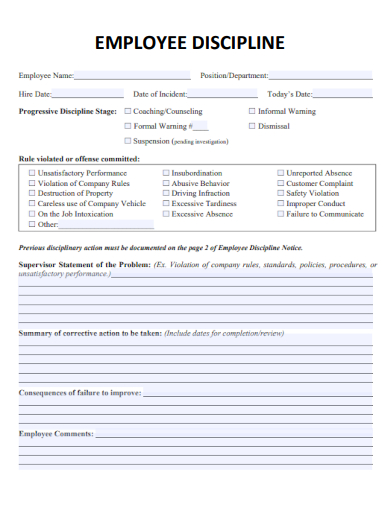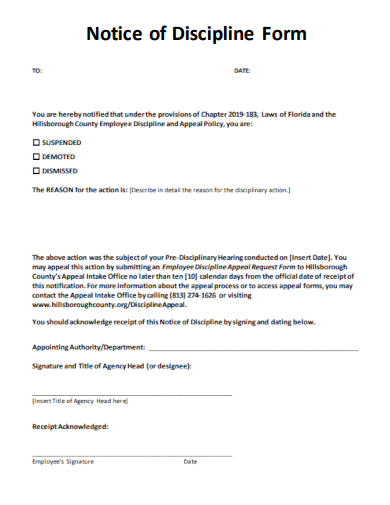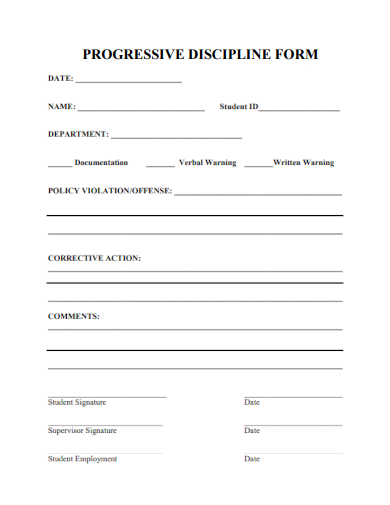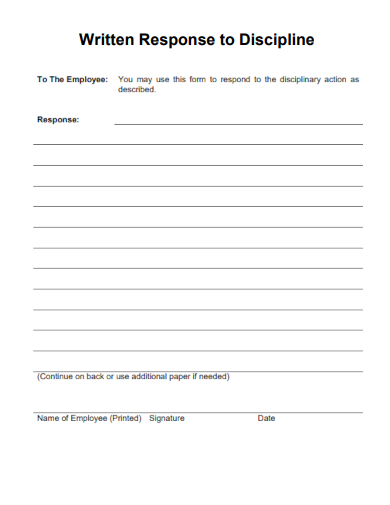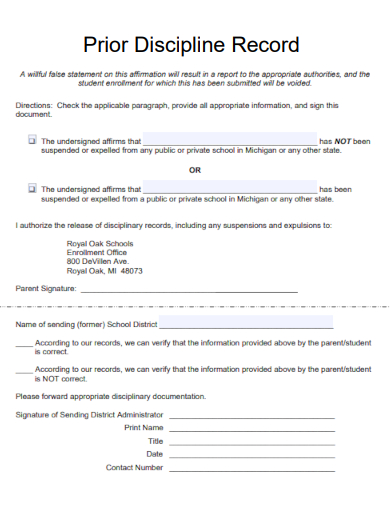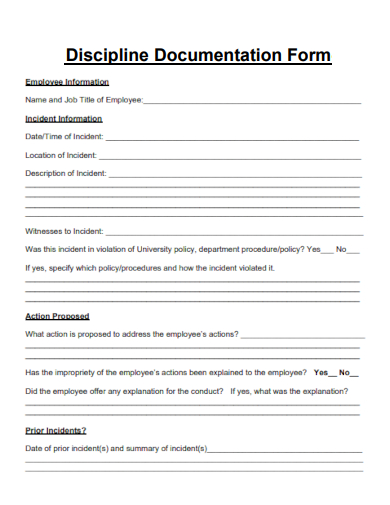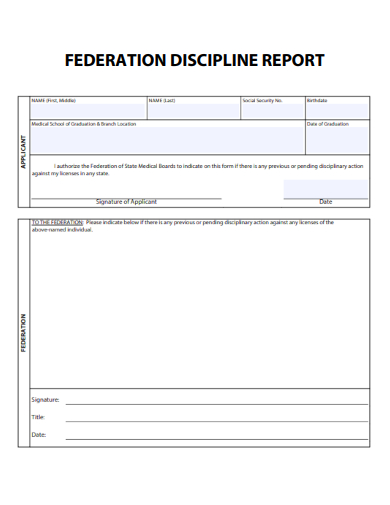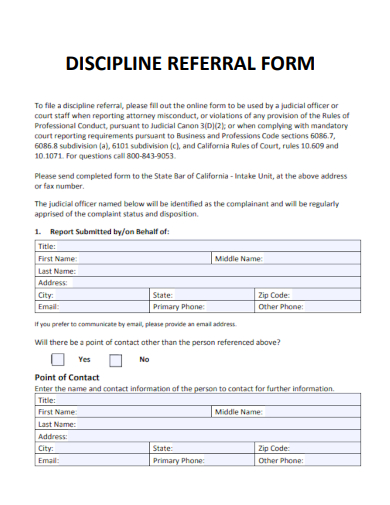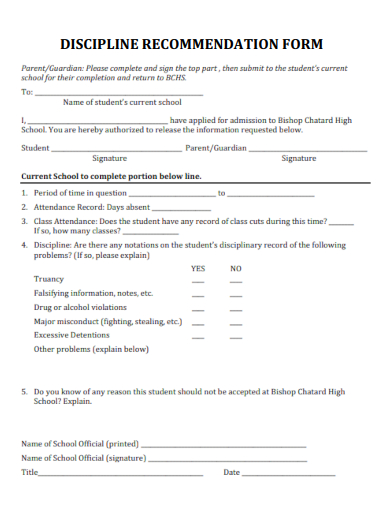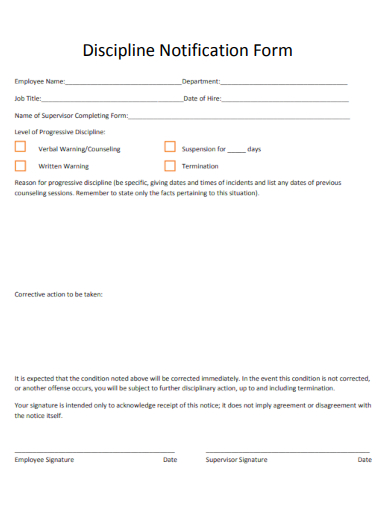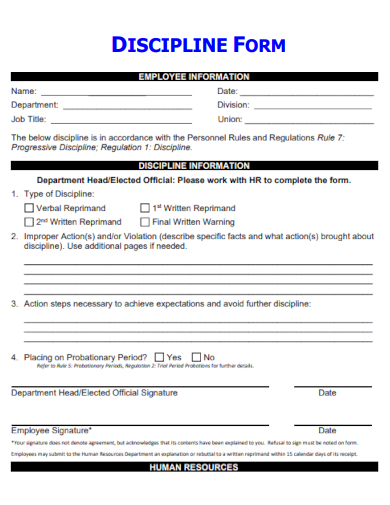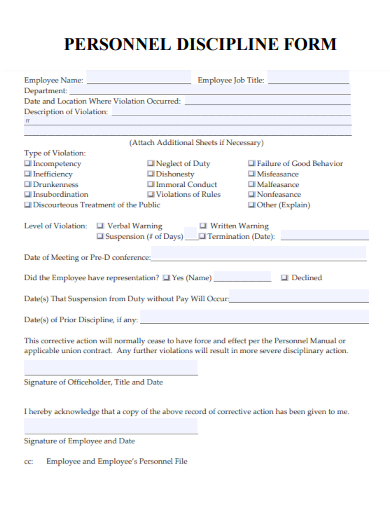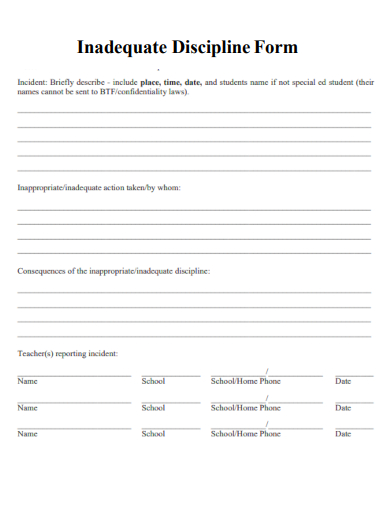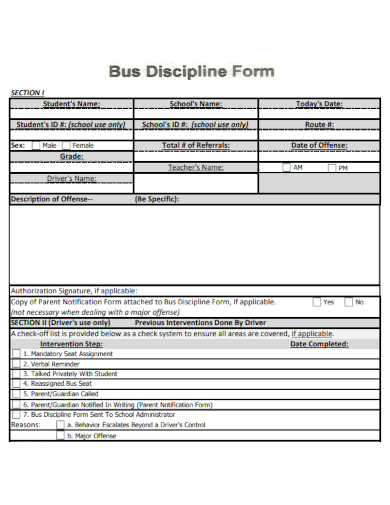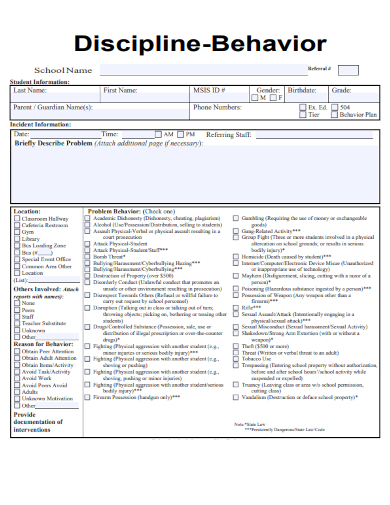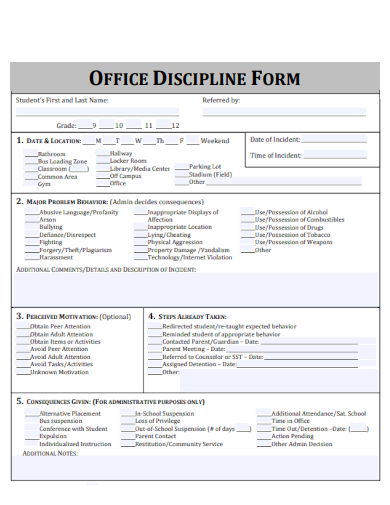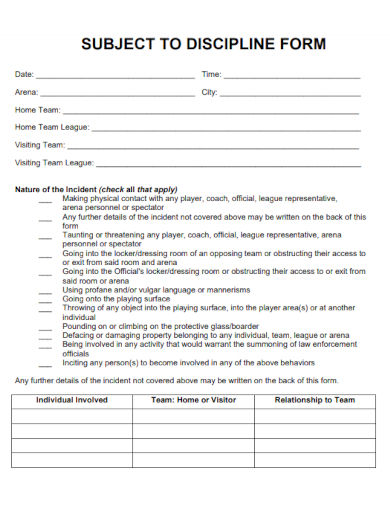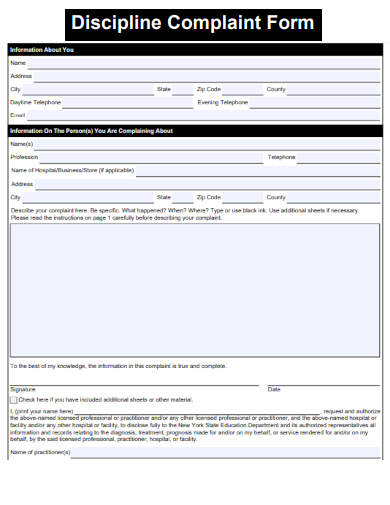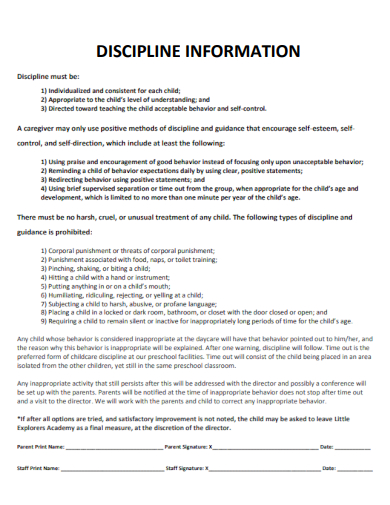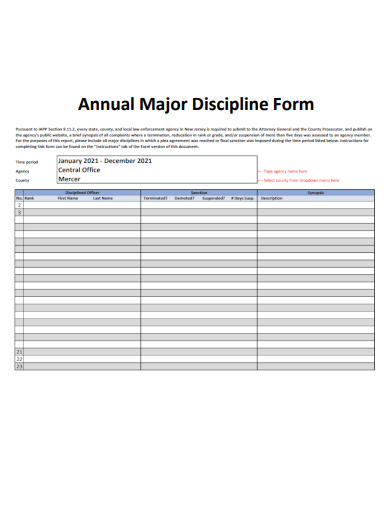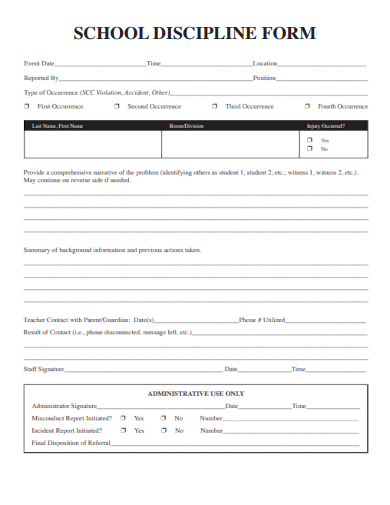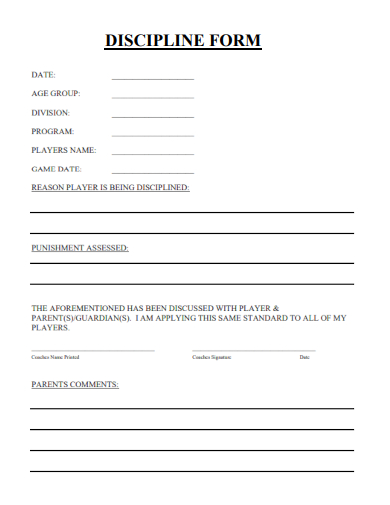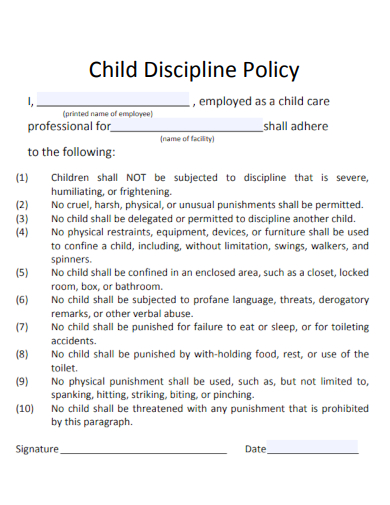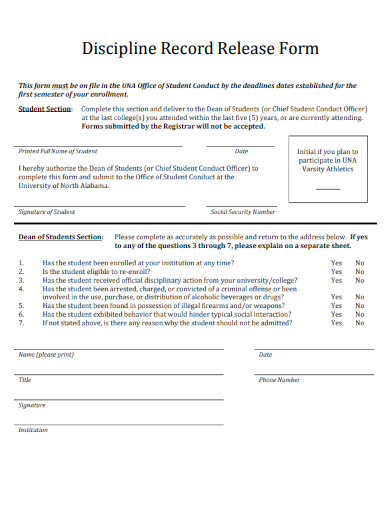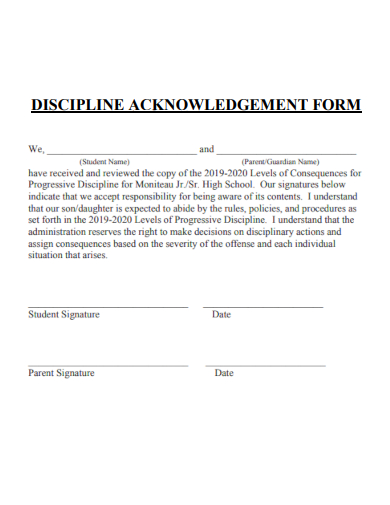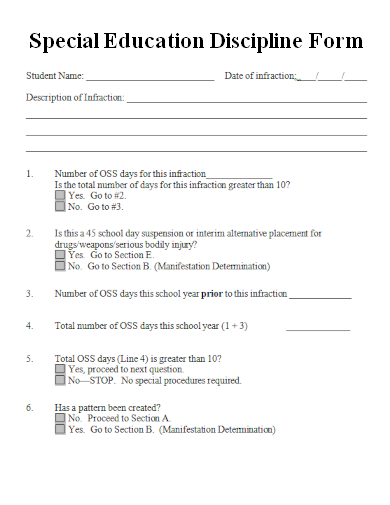Introducing our meticulously crafted Sample Discipline Form Template – your gateway to unlocking unparalleled self-control and productivity. This user-friendly template empowers you to structure your daily routines, set achievable goals, and cultivate the habits necessary for success. Whether you’re striving for personal growth or professional excellence, our form ensures you stay on track. Say goodbye to procrastination and hello to a more disciplined, organized life. Start your journey towards a more focused and accomplished you with our Sample Discipline Form Template today
FREE 29+ Discipline Form Samples
1. Sample Student Discipline Referral Form
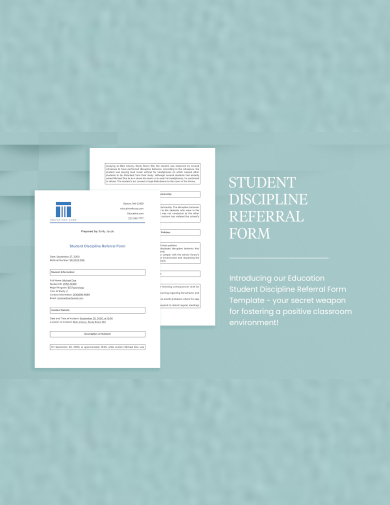
2. Sample Employee Discipline Form Template
3. Sample Notice of Discipline Form Template
4. Sample Progressive Discipline Form Template
5. Sample Written Response Form to Discipline Template
6. Sample Prior Discipline Record Form Template
What is a discipline form?
A discipline form, often referred to as a disciplinary action form or employee discipline form, is a document used in various organizational settings, such as businesses, schools, and government agencies, to record and manage instances of employee or student misconduct, violations of rules, or poor performance. This form plays a crucial role in maintaining order, fairness, and accountability within an organization. Here, we’ll delve into the key aspects of a discipline form, its purpose, and its significance.
Purpose of a Discipline Form:
The primary purpose of a discipline form is to document and address issues related to behavior or performance that are not in line with the established standards or policies of an organization. It serves several essential functions:
Record Keeping: It provides a systematic way to record incidents of misconduct or poor performance. This documentation is invaluable for tracking patterns of behavior over time and for legal purposes, if necessary.
Communication: Discipline forms facilitate communication between supervisors, managers, and employees or students. They serve as a means to inform individuals about their violations or shortcomings and to outline any corrective actions or consequences.
Accountability: By documenting incidents, discipline forms help establish accountability. They ensure that individuals are aware of the consequences of their actions and can be held responsible for their behavior.
Components of a Discipline Form:
A typical discipline form includes various sections and details, such as:
Employee/Student Information: This section records the name, identification number, job title, or grade level of the individual in question.
Description of Incident: Here, the form captures the specifics of the incident, including date, time, location, and a detailed description of what occurred.
Witness Statements: If applicable, there may be space for witnesses to provide their accounts of the incident.
Supervisor/Authority Assessment: This section is where the supervisor or person in authority assesses the incident and determines the appropriate action or consequence.
Action Plan: It outlines the steps that the individual needs to take to rectify the situation, such as training, counseling, or deadlines for improvement.
Signatures: The form typically requires signatures from the employee or student involved, as well as from the supervisor or authority figure.
Types of Discipline Forms:
There are various types of discipline forms, tailored to specific situations:
Verbal Warning: This is an informal, oral communication of concerns, typically used for minor infractions. It may not always be documented in writing.
Written Warning: A written warning is more formal and often represents the first official step in the disciplinary process. It outlines the issue, the required corrective action plan, and the consequences of further violations.
Suspension/Probation: In cases of serious misconduct or repeated violations, employees or students may receive suspension or probation, which is documented on a discipline form.
Termination/Expulsion: In extreme cases, if behavior or performance does not improve or if the violation is severe, the discipline form may lead to termination of employment or expulsion from an educational institution.
Legal Implications:
Discipline forms can have legal implications, as they serve as evidence in case of disputes or legal actions. Therefore, it’s crucial for organizations to ensure that discipline forms are accurate, objective, and compliant with relevant employment or education laws and regulations.
Employee/Student Rights:
Individuals who are subject to discipline have certain rights, including the right to review and respond to the information on the form. They may provide their version of events or objections to the assessment, which should be documented on the form as well.
In summary, a discipline form is a critical tool for organizations to manage and address issues related to employee or student behavior and performance. It helps maintain order, accountability, and fairness while providing a clear record of incidents and their resolutions. Properly implemented discipline processes contribute to a positive organizational culture and ensure that standards and policies are upheld.
7. Sample Discipline Documentation Form Template
8. Sample Federation Discipline Report Form Template
9. Sample Discipline Referral Form Template
10. Sample Discipline Recommendation Form Template
11. Sample Discipline Notification Form Template
12 Unique Purposes of Disciplinary Action Forms:
Disciplinary action forms, critical tools in managing behavior and performance issues within organizations, serve a multitude of distinct purposes. These purposes go beyond documentation and communication and contribute to the overall effectiveness of disciplinary processes. Here are 12 unique purposes of disciplinary action forms:
1. Preservation of Organizational Culture:
Disciplinary action forms help preserve and reinforce the desired organizational culture by ensuring that employees or students adhere to established values and norms. They signal to everyone that certain behaviors or actions are not tolerated, safeguarding the organization’s cultural integrity.
2. Early Intervention and Support:
These forms can trigger early intervention and support mechanisms. When patterns of misconduct or performance issues emerge, disciplinary action forms prompt organizations to offer assistance, coaching, or resources to help individuals improve and prevent further violations.
3. Mitigation of Legal Risks:
By accurately documenting incidents and actions taken, disciplinary action forms mitigate legal risks for organizations. They provide a solid basis for demonstrating that appropriate steps were taken to address issues in compliance with relevant laws and regulations.
4. Enhanced Employee Morale:
When employees observe that disciplinary processes are consistently applied, it boosts morale and fosters a sense of fairness. Knowing that misconduct is addressed fairly and that violators are held accountable can improve the overall workplace atmosphere.
5. Educational Opportunities:
In educational settings, discipline forms can be used as teaching tools. They help students understand the consequences of their actions, encouraging them to make responsible choices and develop essential life skills, such as conflict resolution and self-regulation.
6. Prevention of Retaliation:
Disciplinary action forms can prevent retaliation by ensuring that incidents are thoroughly documented and that the responsible parties are held accountable. This discourages individuals from taking matters into their own hands and promotes reliance on established procedures.
7. Transparency in Promotion and Hiring:
For employees, a documented disciplinary history can provide transparency in promotion and hiring decisions. Supervisors and HR professionals can assess an individual’s growth and improvement over time, helping them make informed choices.
8. Inclusivity and Diversity Promotion:
Disciplinary action forms can also contribute to promoting inclusivity and diversity within organizations. By addressing issues related to discrimination, harassment, or bias, these forms ensure that all members of the organization are treated with fairness and respect.
9. Customization of Interventions:
These forms enable organizations to tailor interventions to individuals’ specific needs. Rather than adopting a one-size-fits-all approach, organizations can identify the most effective strategies for addressing each unique situation.
10. Strengthening Ethical Values:
By addressing ethical breaches through disciplinary action forms, organizations emphasize the importance of ethical values and principles. This reinforces the organization’s commitment to ethical conduct and ethical decision-making.
11. Building a Positive Reputation:
Effectively handling disciplinary matters and using these forms to demonstrate fair and just processes contribute to building a positive reputation for the organization. It showcases the organization’s commitment to responsible management and ethical conduct.
12. Encouraging Responsibility and Self-Reflection:
Disciplinary action forms encourage individuals to take responsibility for their actions and engage in self-reflection. By documenting incidents and consequences, individuals may be prompted to evaluate their choices and make positive changes.
In summary, disciplinary action forms serve a diverse array of purposes, beyond their fundamental role of documenting incidents and consequences. These forms are essential tools in shaping organizational culture, enhancing accountability, promoting inclusivity, and safeguarding legal compliance. When utilized strategically, they contribute to the holistic development and success of organizations and educational institutions.
12. Sample Discipline Form Blank Template
13. Sample Personnel Discipline Form Template
14. Sample Inadequate Discipline Form Template
15. Sample Discipline Action Form Template
16. Sample Discipline Form Standard Template
What are the forms of disciplinary action?
Disciplinary actions are measures taken by organizations, educational institutions, or authorities to address issues related to employee or student behavior, conduct, or performance. These actions are designed to maintain order, uphold standards, and foster accountability. The forms of disciplinary action can vary in severity and can be tailored to the specific circumstances. Here are several common forms of disciplinary action:
Verbal Warning:
A verbal warning is an informal, oral communication from a supervisor, manager, or authority figure to an employee or student who has violated a policy or committed a minor infraction. It serves as an initial notice and may not be documented in writing. Verbal warnings are typically used for minor issues as a first step in addressing misconduct.
Written Warning:
A written warning is a more formal disciplinary action that is documented in writing. It outlines the issue, the specific violation, and the consequences of further infractions. Written warnings are often used for more serious violations or as a follow-up to a verbal warning. They provide a clear record of the incident and expectations for improvement.
Probation or Performance Improvement Plan (PIP):
Probation or the implementation of a Performance Improvement Plan (PIP) is a structured approach to addressing ongoing performance issues. During this period, the employee or student is closely monitored, and specific goals and timelines for improvement are established. Failure to meet the defined criteria during probation may lead to more severe consequences.
Suspension:
Suspension involves the temporary removal of an employee from work or a student from educational activities. It is often used for more serious misconduct or repeated violations. The duration of suspension can vary, and it may be with or without pay or academic credit. During suspension, individuals are expected to reflect on their behavior and take corrective action.
Demotion or Grade Reduction:
In employment settings, demotion may be used as a disciplinary action, where an employee is moved to a lower-level position with reduced responsibilities and pay. In educational settings, a grade reduction may be applied, resulting in a lower academic standing due to academic misconduct.
Termination or Expulsion:
Termination of employment and expulsion from an educational institution are the most severe forms of disciplinary action. These actions are taken when there is significant and irreparable misconduct or when an individual fails to meet the required standards despite previous warnings and interventions. Termination and expulsion are often the last resort in disciplinary processes.
Legal Action:
In some cases, particularly for egregious violations of the law, legal action may be pursued. This can involve filing criminal charges or civil lawsuits against individuals who have engaged in illegal activities that warrant such actions.
Restitution and Compensation:
For financial or property-related misconduct, disciplinary actions may include restitution, where individuals are required to repay damages caused. Compensation may also be part of the resolution process, where victims are compensated for losses incurred.
Training and Counseling:
Disciplinary action may include mandatory training or counseling sessions designed to address specific issues or improve skills. These interventions aim to help individuals develop and avoid future misconduct.
Revocation of Privileges:
In educational institutions or certain workplaces, disciplinary action can involve revoking privileges, such as access to specific facilities, equipment, or benefits, as a consequence of misconduct.
Written Apology or Reflection Assignment:
As a less severe form of discipline, individuals may be required to write a formal apology or complete a reflection assignment. This action encourages self-reflection and acknowledgment of wrongdoing.
Mediation and Conflict Resolution:
In some situations, mediation and conflict resolution processes may be used as disciplinary actions. This involves facilitated discussions between parties to resolve disputes and conflicts in a constructive and mutually acceptable manner.
The choice of disciplinary action depends on the nature and severity of the misconduct or performance issue, organizational policies, and applicable laws and regulations. Effective disciplinary actions should be proportionate, fair, and focused on helping individuals improve while safeguarding the organization’s integrity and standards.
17. Sample Bus Discipline Form Template
18. Sample Discipline Behavior Form Template
19. Sample Office Discipline Form Template
20. Sample Subject to Discipline Form Template
21. Sample Discipline Complaint Form Template
22. Sample Discipline Information Form Template
23. Sample Annual Major Discipline Form Template
24. Sample School Discipline Form Template
25. Sample Discipline Form Printable Template
26. Sample Child Discipline Policy Form Template
27. Sample Discipline Record Release Form Template
28. Sample Discipline Acknowledgment Form Template
29. Sample Classroom Discipline Form Template
30. Sample Special Education Discipline Form Template
Creating Your Own Disciplinary Form: A Tailored Approach
Designing a disciplinary form is a meticulous process that allows organizations and educational institutions to effectively address behavioral, conduct, or performance issues. Here’s a comprehensive guide to creating your disciplinary form:
Clearly Define the Scope and Objectives:
Before diving into form creation, establish a clear understanding of the form’s scope and objectives. Determine the specific behaviors, conduct issues, or performance concerns that the form will address. These objectives will serve as your guiding principles throughout the design process.
Choose a User-Centric Format:
Select a format that prioritizes user-friendliness and ease of navigation. Whether you opt for a digital, electronic format or a traditional paper-based form, make sure that it is designed for intuitive use and efficient data entry.
Craft a Custom Header and Title:
Give your disciplinary form a professional touch with a custom header featuring your organization’s name, logo, and contact details. Craft a succinct and descriptive title, such as “Employee Behavior Report” or “Student Conduct Violation Form,” to clearly convey its purpose.
Outline Incident-Specific Details:
Dedicate a section to capture the essential information related to the incident:
Record the date and time of the occurrence.
Specify the incident’s location.
Encourage a detailed narrative description of the event, focusing on key facts and context.
Individual Information Zone:
Create space for documenting essential details about the employee or student involved:
Gather their full name.
Record their employee or student ID number.
Note their job title (for employees) or grade level (for students).
Include contact information, such as email addresses and phone numbers.
Witness Statements (if Relevant):
If witnesses were present during the incident, provide a designated section for their statements and observations. Request their names, contact particulars, and a comprehensive account of what they witnessed.
Assessment and Decision-Making Area:
Establish a segment where supervisors, managers, or authority figures can assess the incident and make informed decisions regarding disciplinary actions. Include fields for documenting their observations, judgments, and next steps.
Constructive Action Plan and Recommendations:
Devote a space to outline the action plan and recommendations for addressing the situation. Specify any corrective actions, suggested training, or counseling requirements, and set clear expectations with associated timelines and follow-up actions.
Signature Block and Acknowledgment:
Allocate areas for both the individual involved and the supervisor or authority figure to affix their signatures. Signatures signify acknowledgment of the form’s contents and a mutual understanding of the proposed actions.
Review for Compliance and Legal Adherence:
Before finalizing your form, perform a thorough review to ensure compliance with pertinent laws, regulations, and organizational policies. Consider consulting legal and HR experts to guarantee its legality and appropriateness.
Optimize Formatting and Clarity:
Prioritize clarity in your form’s design and formatting. Employ clear headings, bullet points, and concise language to enhance readability. Maintain a consistent, professional design throughout the document.
Efficient Access and Distribution:
Determine how your form will be accessed and distributed within your organization or institution. Ensure that it is readily available to authorized personnel responsible for initiating disciplinary actions or completing the form. Integrating it into an electronic document management system can streamline accessibility.
Training and User Familiarization:
Conduct training sessions to equip personnel responsible for utilizing the form with the necessary skills and knowledge. Ensure they grasp the form’s purpose, correct completion procedures, and the significance of adhering to established disciplinary protocols.
Continuous Enhancement and Adaptation:
Commit to regular reviews and updates of your disciplinary form. This ensures alignment with evolving organizational needs and industry best practices. Encourage feedback from users to pinpoint areas for improvement and to guarantee the form’s enduring effectiveness.
By following these steps, you can create a disciplinary form tailored to your unique organizational or educational institution’s needs and requirements. A well-crafted disciplinary form promotes consistency, fairness, and accountability in addressing behavioral or performance concerns.
Related Posts
Parent Consent Form Samples & Templates
Sample Release of Liability Forms
Sample Training Feedback Forms
Sample Sworn Affidavit Forms
Agreement Form Samples & Templates
Vehicle Inspection Forms Samples & Templates
Sample Employee Advance Forms
Sample Child Travel Consent Forms
Sample Testimonial Request Forms
Sample Employee Details Forms
Sample Divorce Forms
Sample Attestation Forms
Employee Performance Appraisal Form Templates
FREE 9+ Sample Presentation Evaluation Forms in MS Word
FREE 10+ School Admission Form Samples & Templates in MS Word | PDF

